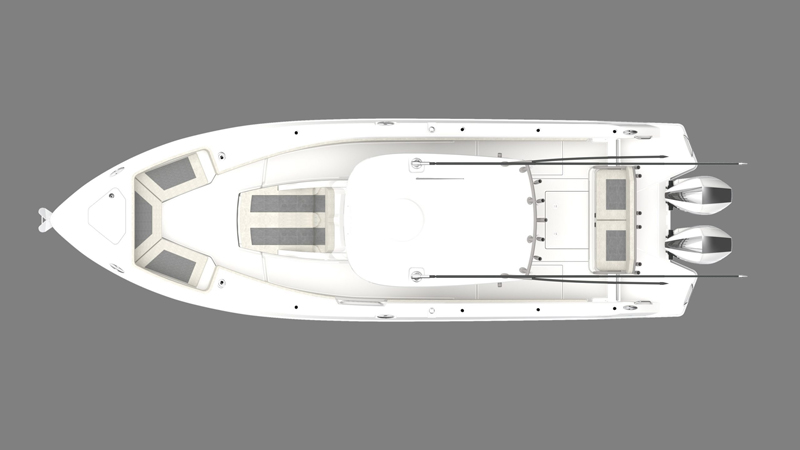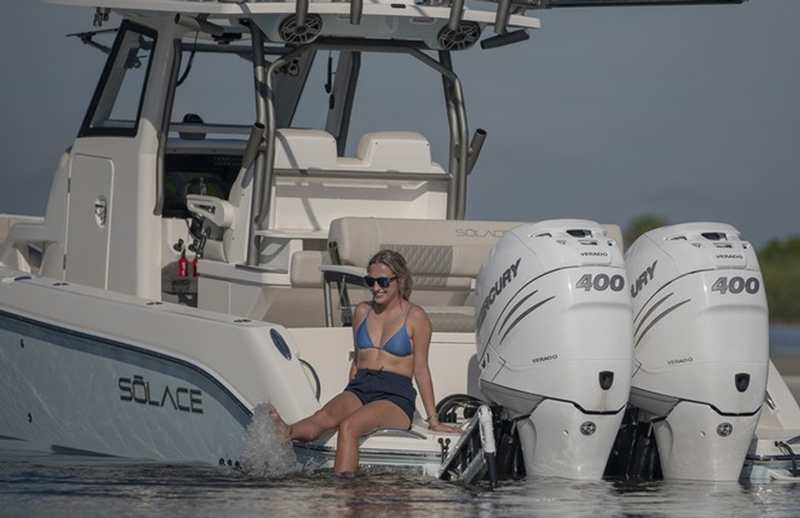You wish there was a hot new center console fishing machine that pulled no punches, broke all barriers, and was so jam-packed with tech it would make a NASA engineer drool with envy? That boat already exists: the Solace 30 HCS. Join us for a sea trial and walkthrough on video.
For those who aren’t familiar with Solace, this is the builder that was launched in 2019 by CEO Stephen Dougherty, one of the founders of Edgewater Boats and then Everglades Boats along with his father Bob Dougherty of Boston Whaler fame. Solace entered the market at the very top of the tech curve, building boats out of epoxy-infused carbon fiber and Innegra. The carbon fiber and epoxy produce the most strength for the least weight, while the use of Innegra — a hydrophobic material now being used in ballistic protection gear, Formula-1 race cars, and high-impact sports helmets — reduces brittleness, dampens vibration, and boosts impact resistance.

Even setting construction aside the 30 HCS is a big a departure from the norm, hitting the water as the biggest hybrid bay boat design we’ve seen yet. While some will feel it’s a stretch to call a 30-footer a hybrid bay boat, the 30 HCS does indeed have lower gunwales than usual for Solace, elevated forward casting positions, and the ability to get into water barely a foot and a half deep thanks to an engine-up draft of 19 inches. The hull design is rather radical as well, with twin steps, a 37-degree deadrise entry at the bow, and a 21-degree transom deadrise.
The net result of this design and build level is impressive prior to exiting the speed zone and nailing the throttles on a pair of 400-hp Verados. After that, it becomes utterly jaw-dropping. When we hit the juice in the lower Chester River late last fall the 30 HCS settled into an easy cruise in the mid-40s, then peaked at a hat-stripping 63 mph. And that was with full fuel, one-third water, and three people aboard, so these are real-world numbers. Responsiveness and handling were off-the-charts amazing, with a mere half-turn of the wheel putting the boat into a graceful arc completely absent of the skittery, loose-handling feel some stepped hulls produce. Cranking the wheel back the other way the hull responded instantaneously and maintained a firm grip on the water. And when we doubled back on our wakes the aggressive entry chewed right through them without banging or bouncing.
It wasn’t rough during our sea trial, but there was a breeze and a slight chop on the river. And as anyone who’s blasted across the water at 63-mph can tell you, at extreme speeds hitting a one-foot wave can be downright jarring. Not in this case. In fact, there was never a bump nor a bang worth noting and we never felt compelled to grasp the pipework with the usual high-speed white-knuckled grip. Try though we may to convey just how effective the tech and the design perform off the dock, this is a case where you’ll have to experience it to believe it — a sea trial will be illuminating, to say the least.
It’s a stretch to find any construction or design downsides, though we will point out that it does make for a very expensive boat. We’ll also note that the painted aluminum pipework doesn’t look or feel quite as slick as powder-coating would, though on the flip side of the coin, it will likely look better a few years down the road since it’s easily touched-up whereas powder-coat never really looks the same once damaged.

This all sounds great if you’re a pure boat nut, but what about viewing the boat from an angling perspective? In the hybrid world the 30 HCS certainly leans more towards big water than skinny. It has a relatively deep cockpit running all the way back to the transom, where there’s an elevated double-wide seat perched atop a pair of 30-gallon livewells. The seat is tricked out with a strut-assisted flip-back backrest that swaps between facing forward for cruising and facing aft for cocktail hour. While some anglers may wish Solace had incorporated an aft casting deck here, others will appreciate the added comfort for the crew. In either case, unlike most aft seat-over-livewell arrangements, accessing the wells is easy and unencumbered.
Up forward the bow is capped with U-shaped seating, and the seat cushions pop off easily to convert into a bow casting platform. When we say “easily,” we mean it. Solace laminates magnets into the seats and weaves them into the cushion bases, so they stay put without needing straps or snaps. But when you want to remove them, they slide right off with a gentle shove-and-lift. There’s also a double-wide lounger in the center of the bow, perched atop the cabin.
About that cabin… try as we might, we can’t think of another 30-foot center console that provides as much space inside the console. A double berth runs forward under the lounger, there’s a head, and there are also stowage compartments, a countertop with a sink, and 6’2” of headroom. Overnighting at the canyons in comfort on a hybrid bay boat just became a realistic option.
Tackle stowage can be found in the inwales and leaning post, a pair of 35-gallon fishboxes evacuated by gulper pumps are integrated into the deck, there’s a rigging station with sink in the back of the leaning post with a Frigid Rigid cooler beneath it, and an upper station is an option for cobia hunting inshore and spotting flotsam-hugging mahi offshore. This boat also comes fully rigged with electronics, including a pair of Garmin 8616 MFDs at the helm, a VHF, and an Airmar 500-watt CHIRP transducer including SideVu and ClearVu functionality. Oh, and you can also control all the boat’s digital switching systems right from those MFDs.

Punches pulled? Zero. Barriers broken? Many. Do we have any NASA engineers out there who are wiping their chin right now? Unconfirmed — but we’re betting the answer is yes.
Solace 30 HCS Specifications
- LOA – 29’10”
- Beam – 9’10”
- Displacement – Est. 9000 lbs., exact TBD
- Draft (hull) – 1’7”
- Transom Deadrise – 21 degrees
- Fuel Capacity – 187 gal.
- Max. Power – 900 hp
- Area Dealers – Bosun’s Marine, Grasonville, MD, (443) 347-6314.